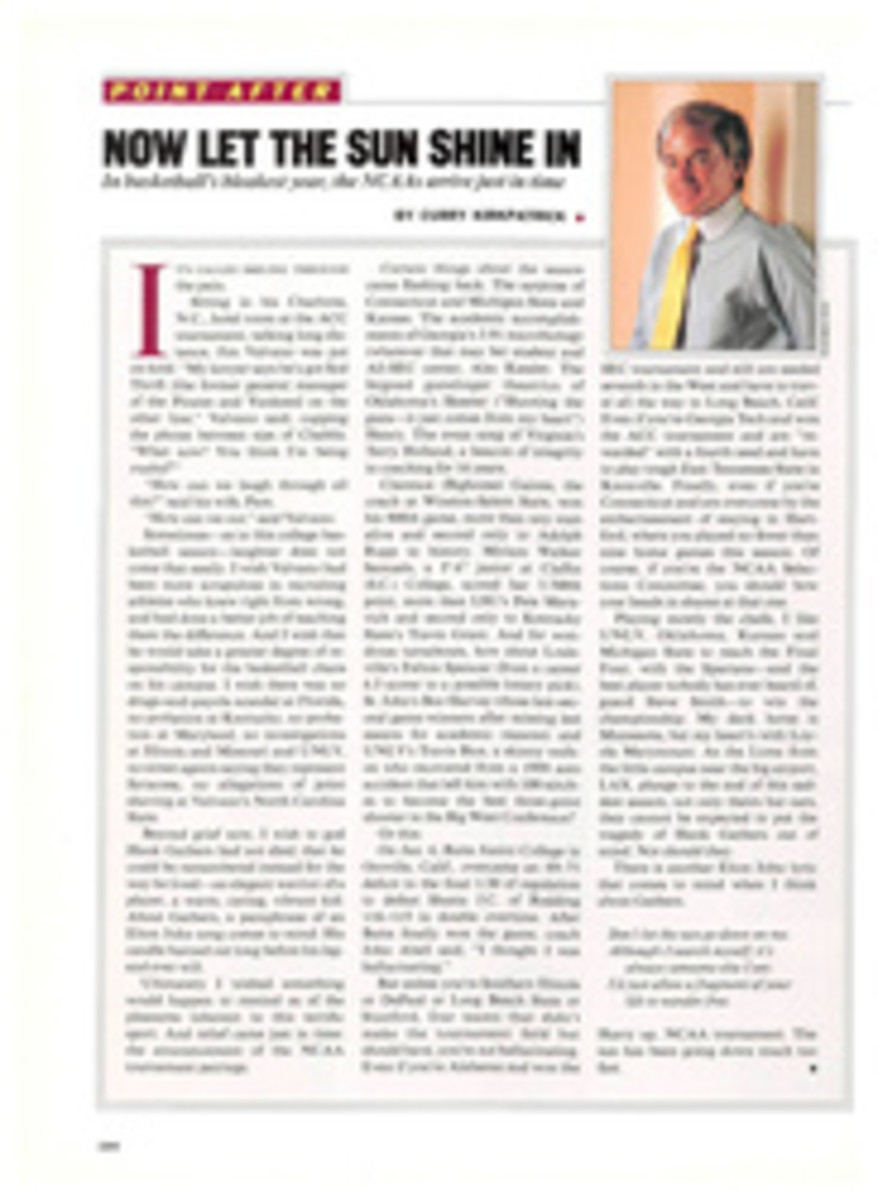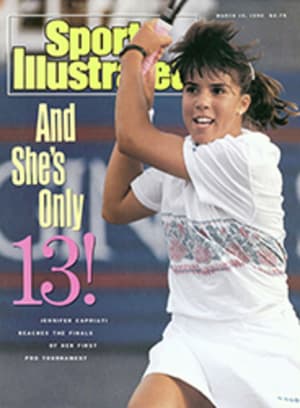
NOT-SO-PAT HAND
Uneasy lies the soul of Lester Patrick over what has become of his namesake division. For that matter, two of his grandsons—Craig Patrick, who is the general manager-coach of the Pittsburgh Penguins, and Dick, the president of the Washington Capitals—aren't sleeping too well, either. In the NHL's low-rent Patrick Division, six teams toss and turn nightly on the same hard bed.
On Sunday night the last-place Philadelphia Flyers, though they were nine games below .500, were only 15 points out of first place. The New York Rangers, who had opened up a gaping—at least by Patrick standards—eight-point lead over the second-place New Jersey Devils, were on their way to their first title of any kind since 1941-42, when Lester, the old Silver Fox himself, was their general manager. But mention the giddy possibility of a division title to Ranger coach Roger Neilson and his face takes on the grim look of a Patrick Division game. "You win a game in this division, and you think about finishing in first place," says Neilson. "Lose one, and you worry about finishing last."
There are two philosophies of hockey in the Patrick: freewheeling, as practiced by Pittsburgh, and bump-and-grind, as demonstrated by the rest of the teams. But there is only one philosophy of life: fatalism. "We've been winning some close ones," says Ranger defenseman Brian Leetch. "We haven't exactly been dominating." So it is that a team representing a spooked-out franchise that last won a Stanley Cup 50 years ago charges onto the ice each night with this ringing battle cry: "We can still mess this up!" All things are possible in the Patrick, where the season always starts over tomorrow.
"I'm not going to say it's bad," says Bill Torrey, the New York Islanders' general manager. "It's, uh, different."
The Patrick Division won't break any records for victories this season, but it may smash the alltime NHL mark for mediocrity previously held by the Norris Division. The Norris, long a deserving object of scorn, now has three teams with winning records. The Patrick, meanwhile, has become, as folks in the division like to say, "competitive night in and night out." Yeah, sure. The Islanders were winless in 12 games (0-9-3) through Sunday and still in the running for a playoff spot. So were the Devils, who three weeks ago had a 1-8-3 stretch. Even the Rangers, who really do have the best team, went 1-11-4 just before the midseason mark. Every team in the Patrick has had a share of first and last place at some point this season.
The Capitals lack a big gun, the Flyers have grown old, the Islanders are too young. The Devils have the most talent but the worst M.O. And the Penguins—with Mario Lemieux incapacitated for perhaps the rest of the regular season with a herniated disk and goalie Tom Barrasso taking personal leave to be with his two-year-old daughter, Ashley, who has cancer—will have to make the playoffs by default.
It never used to be like this. The Patrick Division used to have class. It had "contendahs." The season the division was created, 1974-75, the Flyers won their second straight Stanley Cup. The Islanders won four straight Cups from '80 to '83 and established themselves as one of the great teams in the history of the game. Even after the Isles faltered, the Patrick remained so strong that Washington amassed 100-plus points for three straight seasons ('83-84 through '85-86) and finished second all three times. Over a span of three seasons, from '84-85 through '86-87, the Flyers had either the NHL's best or second-best record and made the Stanley Cup finals twice.
But the Patrick has slipped badly since then. Only the Rangers and Islanders have had winning records outside the division this season. Of the four divisions, only the Patrick doesn't have a cumulative winning record against the rest of the league.
There may be no upsets in the Patrick, but there's always a potential for irony. Which is why you might just like the Capitals' chances: For the past seven seasons, the Caps have had winning records without ever getting out of the divisional playoffs. Now that they've fallen below .500, could it finally be their year?
The Caps usually stumbled in the playoffs because of superior goaltending by the opposition. The Patrick has long been a goaltender's division, and the point could be made that much of this season's mediocrity is a result of good goalies having bad seasons.
Patrick Division netminders have taken turns thwarting Washington in past playoffs. So last week the Capitals' general manager, David Poile, went out and got his own stopper in the person of 34-year-old Mike Liut. Poile acquired Liut from the Hartford Whalers for left wing Yvon Corriveau. The Caps, competent defensively, are ordinary up front. But in the Patrick, boring can be beautiful.
The Flyers, who are stumbling toward their first losing season since 1971-72, are a mix of forwards in decline and immature defensemen. What's more, their three best players—goalie Ron Hextall, defenseman Mark Howe and right wing Tim Kerr—have all missed major portions of the season with injuries.
With harsh reality looming large, Philly general manager Bobby Clarke backed up the moving van before last week's trading deadline and packed off veteran left wing Brian Propp for a draft choice, defenseman Jay Wells for a younger player and a draft choice, and center Dave Poulin to Boston for former Flyer center Ken Linseman. "I always took winning for granted here," says winger Rick Tocchet. "Now we have to be more realistic."
Reality has been hard to measure in New Jersey. At the trading deadline, the Devils added a Slovak, Peter Stastny, to a team that already had two Soviets, two Swedes, a Finn and the usual amalgam of Canadians and Americans. International goodwill has thereby been advanced—and appropriately, too, for a franchise that plays only a long slap shot away from the Statue of Liberty. Turns out, the reason Miss Liberty's arm is up is because she's calling a delayed penalty on New Jersey. Both on and off the ice the Devils simply haven't been speaking the same language this season.
General manager Lou Lamoriello, in an effort to upgrade what used to be a grind-it-out kind of team, has instead created one without a personality. New Jersey has forwards willing to chase the puck but too many European-style defensemen who aren't willing to dump it in. Without much of a forechecking game, the Devils have to score off the initial rush but don't have the freewheeling types to do that consistently. Stastny, a veteran center who had gone stale with the Quebec Nordiques, was acquired at last week's trade deadline for Craig Wolanin, a defenseman of promise who had been shunted aside for Soviets Viacheslav Fetisov and Alexei Kasatonov.
In Lemieux's absence, the Penguins are trying to keep things together with tighter checking and greater attention to detail. These are not normally Pittsburgh's strengths. Besides Lemieux, the injury list includes a key young defenseman, Zarley Zalapski; the rest of the Penguins require constant ministrations to maintain stiff upper lips.
Lemieux's back is responding well to doctoring, and he may try to play the last few regular-season games, providing the Penguins can stay close enough to playoff contention to make those games meaningful. Their inspiration comes from the scoreboard—and they may not have to win too many. In this division everybody else might go on losing.
Certainly the Islanders, who went from last place to first with an improbable 23-6-3 surge, have been tremendously reassuring to their Patrick foes, since they are now free-falling back to reality. "You can't put your finger on any one thing," says Bryan Trottier. O.K., maybe a lack of talent. Pat LaFontaine, who was in on 35% of the Islanders' goals at one point this season, returned last week after having missed six games because of a chip fracture in his left hand. LaFontaine and his white horse are a stirring sight, but the cavalry troop behind him looks a bit ragged. "We really don't have much of a margin for error," says coach Al Arbour.
In the meantime an eerie calm has settled over the usually profane fans at Madison Square Garden. The Rangers, 8-1-2 in their most recent 11 games through Sunday, continue to roll, but their loyal supporters cheer warily, as if waiting to be punched in the stomach. Last season New York was in first place for 79 days. But it finished 37-35-8 and then was bombed out of the playoffs by Pittsburgh in four straight. This time the Rangers actually appear to be peaking at the right time. Since this franchise was put on earth to break hearts, there has to be a catch somewhere.
Maybe it will be on defense, where the Rangers have a good blend of puck-movers and bouncers but are a little thin with David Shaw out for the duration with a shoulder dislocation. Or maybe this really is the best Ranger team since the Herb Brooks-coached models of the early 1980s. John Vanbiesbrouck, pushed for the top job by rookie Mike Richter, is back in top form after suffering through a prolonged slump. Leetch has game-controlling skills and may be just one year away from superstardom.
Neil Smith, the Rangers' rookie general manager, was left a nice inheritance, and he has reinvested it wisely. The January acquisition of Bernie Nicholls, in a trade with the Los Angeles Kings for right wings Tomas Sandstrom and Tony Granato, gave New York a first-class offensive center, which led in turn to better balance on all its lines.
Left wing John Ogrodnick, who was booted off the team last season by then coach Michel Bergeron, has reclaimed his spot among the league's top snipers. The Rangers have plenty of big, aggressive wingers who will not lose the board-and-corner battles that are so important in a playoff series. And management, convinced that 23-year-old winger Ulf Dahlen lacked the speed to deliver on the promise that had made him a No. 1 pick in 1985, traded him to the Minnesota North Stars last week for 30-year-old right wing Mike Gartner.
Gartner, despite his blazing speed and superior shot, has never scored big in the playoffs. But he may not have to in New York. The Rangers play the sort of patient, controlled game that should work at playoff time. That style has also been described by Boston coach Mike Milbury as "boring."
Last month the Rangers were comfortably ahead of the Bruins in a game when New York fans serenaded Mil-bury by chanting, with detectable ennui, "BORR-ing...BORR-ing." During hard times in the Patrick Division, they've learned not to worry about form, only victories. That's because on any given night, one Patrick team figures to tie another one.
PHOTO
PAUL BERESWILL
Philly's Linseman seems to be trying to drag the first-place Rangers—or, at least, Kris King—down to the Flyers' lowlier level.
PHOTO
DAVID E. KLUTHO
With Kasatonov, here manhandled by two Penguins, the Devils have a hellish M.O.
PHOTO
ANTHONY NESTE
Rough stuff from Lindy Ruff (44) and tough stands by Vanbiesbrouck have helped lift the Rangers to the top.
PHOTO
PAUL BERESWILL
[See caption above.]
PHOTO
JERRY WACHTER
Behold! The Capitals' Mike Ridley scored against Chicago, a Norris Division team.

